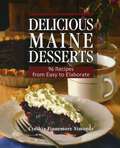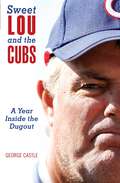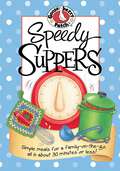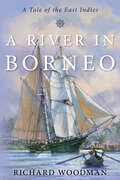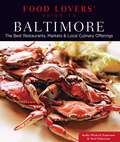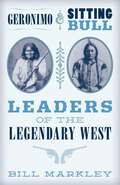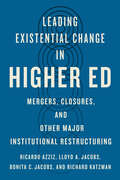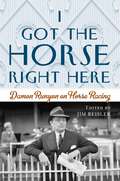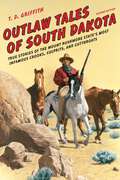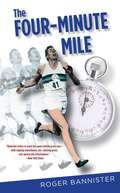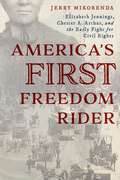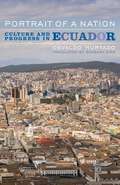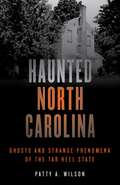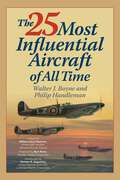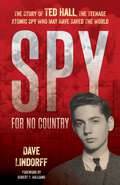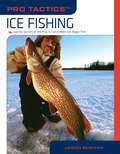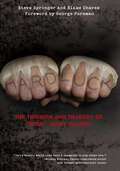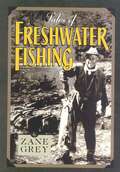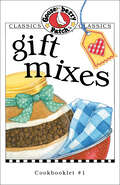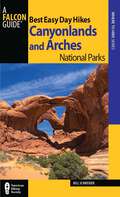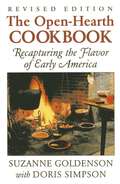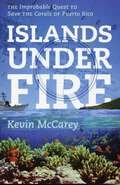- Table View
- List View
Delicious Maine Desserts: 108 Recipes, from Easy to Elaborate
by Cynthia Finnemore SimondsIn Cynthia Finnemore Simonds previous books, she established a reputation for creating original recipes using local ingredients. Now she turns her attention to desserts built on regional foods. Look for recipes that include blueberries and other fruits, as well as squash, rhubarb, maple syrup, and items produced in Maine wineries and distilleries. Recipes featuring molasses, citrus, rum, chocolate, and other imported goodies recall Maine's seafaring days, when ships carried products from around the world.
Sweet Lou and the Cubs: A Year Inside The Dugout
by George CastleSweet Lou and the Cubs chronicles from the inside-out Lou Piniella&’s stirring and celebrated quest to reverse the team&’s fortunes after a record 100 years without a World Series championship. Drawing on the story of Piniella&’s Cubs debut in 2007 and his history as baseball&’s ultimate firebrand, veteran Cubs reporter George Castle gives fans the real story behind the building of the best Cubs team in decades. In riveting detail he traces how the Cubs swept into the 2008 playoffs as the favorite to represent the National League in the World Series, but then went down in shocking defeat—leaving millions of fans to pin their wounded hopes on the prospects of their remade team finally turning the tide in 2009. . . .This is sports writing at its best, focusing on Piniella&’s old-school style and baseball scientist&’s mind; wild swings in the Cubs&’ win-loss fortunes; the inside scoop on a Cubs&’ front office that has been dramatically more aggressive than its predecessors; the byplay of daily clubhouse life and profiles of key players; and Piniella&’s colorful proclamations and homespun philosophy, along with his interactions with his coaches, the team, ball-club executives, media, fans, and celebrity hangers-on.
Speedy Suppers
by Gooseberry PatchSimple meals for busy families! Speedy Suppers cookbook features delicious dishes that are ready in 30 minutes or less like baked ziti supreme, quick-as-lightning enchiladas and easy, breezy caramel brownies.
River in Borneo: A Tale of the East Indies
by Richard WoodmanIt is the summer of 1964 during the Far Eastern war euphemistically called &‘Confrontation.&’ A British Royal Marine patrol has orders to penetrate Indonesian Borneo to locate a river thought by Allied intelligence to be in use by the Indonesians to build up supplies before launching a major attack on Sarawak. Charged with this mission, Lieutenant Charles Kirton makes a most extraordinary discovery amid the dense mangrove swamps bordering a river in Borneo. What he finds not only enables Kirton to fulfil his mission, but also turns out to be intensely personal and macabre as the truth behind the strange event is revealed. From this highly charged opening sequence, the story flashes back a century to 1867, when young Henry Kirton, second officer of the auxiliary steamship River Tay, is dumped ashore in Singapore, badly injured by a fall from the rigging of his ship. Woodman&’s compelling tale has echoes of Joseph Conrad.
Our Favorite Apple Recipes
by Gooseberry PatchFrom Apple Pancakes to Grilled Cheese Sandwiches and, of course, Grandma's Apple Pies that are sure to get mouths watering and tastebuds tingling!
Food Lovers' Guide to® Baltimore: The Best Restaurants, Markets & Local Culinary Offerings (Food Lovers' Series)
by Neal Patterson Kathryn Wielech PattersonThe Best Restaurants, Markets & Local Culinary Offerings The ultimate guides to the food scene in their respective states or regions, these books provide the inside scoop on the best places to find, enjoy, and celebrate local culinary offerings. Engagingly written by local authorities, they are a one-stop for residents and visitors alike to find producers and purveyors of tasty local specialties, as well as a rich array of other, indispensable food-related information including:• Favorite restaurants and landmark eateries• Farmers markets and farm stands• Specialty food shops, markets and products• Food festivals and culinary events• Places to pick your own produce• Recipes from top local chefs • The best cafes, taverns, wineries, and brewpubs
Geronimo and Sitting Bull: Leaders of the Legendary West
by Bill Markley**2022 Will Rogers Medallion Award Silver Winner for Western Biographies and Memoirs**Two Native American leaders who left a lasting legacy, Geronimo and Sitting Bull.Most Americans and many people worldwide have heard these two famous names. Today, however, the general public knows little about the lives of these great leaders. During the second half of the nineteenth century when they opposed white intrusion and expansion into their territories, just the mention of their names could spark fear or anger. After they surrendered to the army and lived in captivity, they evoked curiosity and sympathy for the plight of the American Indian. Author Bill Markley offers a thoughtful and entertaining examination of these legendary lives in this new joint biography of these two great leaders. .
Leading Existential Change in Higher Ed: Mergers, Closures, and Other Major Institutional Restructuring
by Ricardo Azziz Lloyd A. Jacobs Bonita C. Jacobs Richard KatzmanA guide on how to strategically lead institutions of higher education through mergers and other major institutional restructurings. <P><P> Higher education is at a crossroads. With demographic shifts, financial constraints, shrinking enrollments, and the demand for institutional innovation, universities and colleges are grappling with monumental challenges. In Leading Existential Change in Higher Ed, Ricardo Azziz, Lloyd A. Jacobs, Bonita C. Jacobs, and Richard Katzman offer invaluable insights into how institutional leaders can successfully navigate mergers, closures, and other large-scale transformations. <P><P> The authors explore the critical components of successfully leading institutional restructuring—such as pacing change, managing resistance, and harnessing the power of early adopters—while also recognizing the obstacles leaders face. Using vivid examples from real mergers in higher education, this book demonstrates how and why versatile leadership is essential as colleges and universities face an increasingly uncertain future. Whether managing a complex merger, preparing for potential closure, or undertaking other major institutional restructuring, leaders must be willing to embrace difficult decisions and act decisively before institutional decline becomes irreversible. <P><P> Drawing on decades of leadership experience and research, this book provides actionable strategies for higher education leaders to take charge of change, rather than be swept away by it. Leading Existential Change in Higher Ed is an essential guide for college and university presidents and chancellors, trustees, policymakers, and other executives and stakeholders who seek to lead and guide institutions of higher education through turbulent times.
I Got the Horse Right Here: Damon Runyon on Horse Racing
by Joseph James ReislerBurned out by working the baseball beat for years, in the summer of 1922 Damon Runyon was looking for a new sport to cover for The New York American as a change of pace. Having pilloried golf just a few years before, he went to Saratoga that August to sample horse racing and found that &“There, right in front of him, were so many of the characters he so loved from his time covering the comings and goings of the Manhattan night crowd.&” This was just the tonic Runyon needed to emerge from his malaise. Runyon didn&’t just cover the great races and which horse won: he would get to the track days before and roam along the backstretch, speaking with the trainers, the gamblers, the rich owners, and the wise guys, many of which became model characters in his fiction and in the musical Guys and Dolls. This book collects the best of Runyon&’s horse racing columns to 1936, when he moved on to other beats.
Outlaw Tales of South Dakota: True Stories Of The Mount Rushmore State's Most Infamous Crooks, Culprits, And Cutthroats (Outlaw Tales)
by T. D. GriffithMassacres, mayhem, and mischief fill the pages of Outlaw Tales of South Dakota. Ride with horse thieves and cattle rustlers, stagecoach, and train robbers. Duck the bullets of murderers, plot strategies with con artists, hiss at lawmen turned outlaws. A refreshing new perspective on some of the most infamous reprobates of the Great Plains.
Four-Minute Mile
by Roger Bannister"Bannister writes in much the same fashion as he runs-with rippling smoothness, eye-catching grace, and spectacular effectiveness." -The New York Times "It is strange that the intrinsically simple and unimportant act of placing one foot after another for 1,760 yards, as fast as possible, should become such an important sporting achievement. I think the appeal lies in its simplicity-it needs no money, no equipment, no particular physique, no knowledge, no education-and in a world of increasingly complex technology, it stands out as a naive statement about the nature of man. A man can, with his own two feet, overcome severe difficulties to reach a pinnacle upon which he can declare, 'No one has done this before.' " -Roger Bannister, from the Introduction All sports have pivotal moments, single events that change perceptions forever after. For the sport of running, such a moment occurred on a blustery May afternoon in 1954, when Roger Bannister broke the four-minute mile. This is the story of that epic run. Today, fifty years later, lovers of the sport--runners and non-runners alike--will be moved by this modest but impassioned story of one of sport's true heroes.
America's First Freedom Rider: Elizabeth Jennings, Chester A. Arthur, and the Early Fight for Civil Rights
by Jerry MikorendaIn 1854, traveling was full of danger. Omnibus accidents were commonplace. Pedestrians were regularly attacked by the Five Points&’ gangs. Rival police forces watched and argued over who should help. Pickpockets, drunks and kidnappers were all part of the daily street scene in old New York. Yet somehow, they endured and transformed a trading post into the Empire City. None of this was on Elizabeth Jennings&’s mind as she climbed the platform onto the Chatham Street horsecar. But her destination and that of the country took a sudden turn when the conductor told her to wait for the next car because it had &“her people&” in it. When she refused to step off the bus, she was assaulted by the conductor who was aided by a NY police officer. On February 22, 1855, Elizabeth Jennings v. Third Avenue Rail Road case was settled. Seeking $500 in damages, the jury stunned the courtroom with a $250 verdict in Lizzie&’s favor. Future US president Chester A. Arthur was Jennings attorney and their lives would be forever onward intertwined. This is the story of what happened that day. It&’s also the story of Jennings and Arthur&’s families, the struggle for equality, and race relations. It&’s the history of America at its most despicable and most exhilarating. Yet few historians know of Elizabeth Jennings or the impact she had on desegregating public transit.
Portrait of a Nation: Culture and Progress in Ecuador
by Osvaldo HurtadoA case study of why Third World countries are still poor, the premise of this book is that while some progress has been made in transforming the political economy of Ecuador, certain behaviors, beliefs and attitudes have kept the country from developing in ways that otherwise would have been possible. As the author asserts, for almost five centuries the cultural habits of Ecuadorian citizens have constituted a stumbling block for individual economic success. Still, he concludes, people's cultural values are not immutable: inconvenient customs can be changed or influenced by the economic success of immigrants. This is the challenge that Ecuador faces in the twenty-first century.
Day Trips® from Los Angeles: Getaway Ideas for the Local Traveler
by Maria OliaDay Trips® from Los Angeles is packed with hundreds of exciting things for locals and vacationers to do, see, and discover not far from Los Angeles, California. Los Angeles County has 9.8 million residents, and more than 60% of all visitors to Santa Barbara—a big part of this book—are from Los Angeles County! Trips are listed geographically, starting closest to downtown Los Angeles and radiating outward. Despite Southern California&’s car-crazy reputation, this guide includes car-free options where applicable.* Do something star-studded: Explore Hollywood, Burbank, and Universal City & Universal Studios.* Do something sunny: Visit Malibu, twenty-three miles of sun, sand, and surf; Santa Catalina Island, a world away twenty-six miles out to sea; or Marina Del Rey/Venice Beach, quintessential So Cal.* Do something kid-approved: Get a taste of Buena Park/Knott&’s Berry Farm, or visit the Happiest Place on Planet Southern California, Anaheim/Disneyland.
Haunted North Carolina: Ghosts and Strange Phenomena of the Tar Heel State (Haunted Series)
by Patty A. WilsonNorth Carolina is rich in Native American, Colonial, and Civil War history, and this heritage brings stories of ghosts and creatures from coastal tidewater to the western mountains. Readers will encounter the spirit of infant Virginia Dare in the form of a white deer, shipwreck survivors guided by ghosts to safety, a Halifax County reverend's encounter with the Devil, phantom marauders at Hannah's Creek Swamp, the spirit who directed his will from the grave, hauntings in the State Capitol, and mysterious figures at Devil's Stairs.
The 25 Most Influential Aircraft of All Time
by Walter Boyne Philip HandlemanThe 25 Most Influential Aircraft of All Time conveys the fascinating progression of flying technology from flimsy wood-and-fabric biplanes to thunderous supersonic wonders. Aviation&’s most historically relevant and arguably most influential aircraft – planes like the elliptical-winged Spitfire, the blisteringly-fast X-15, and the ubiquitous Learjet – are dramatically showcased in individual chapters. Factors like performance, price, operational efficiency, and perceptions in popular culture are examined. People are just as important as hardware in the discussion of the world&’s greatest aircraft. The larger-than-life characters who designed and built these aeronautical marvels – men like the reclusive Howard Hughes and the demanding Clarence &“Kelly&” Johnson – are an indispensable part of the story. So, too, are the fearless pilots like Charles Lindbergh and Chuck Yeager who gave life to the shining examples of a new and dynamic industry. The authors have flown or flown in many of the featured aircraft and they knew many of the luminous personalities involved, enabling them to share unique perspectives.The preface is written by William Lloyd Stearman, a former staff member of the National Security Council and the son of famed industry engineer Lloyd Stearman. The introduction is written by Norman R. Augustine, the retired Chairman and CEO of Lockheed Martin Corporation. The foreword is written by Burt Rutan, the renowned aircraft designer and founder of Scaled Composites. Each aircraft is magnificently illustrated in color, mostly with paintings by leading aviation artists.
Spy for No Country: The Story of Ted Hall, the Teenage Atomic Spy Who May Have Saved the World
by Dave LindorffAt 18 years of age, Theodore Hall was the youngest physicist on the Manhattan Project, hired as a junior at Harvard and put to work at Los Alamos in 1944. Assigned the job of testing and refining the complex implosion system for the plutonium bomb, Hall was described as &“amazingly brilliant&” by his superiors on the project, many of whom were Nobel Prize winners. But what Hall&’s colleagues didn&’t know was that the teenaged Hall was also the youngest spy taken on by the Soviet Union in search of secrets to the atomic bomb. Spy With No Country tells the gripping story of a brilliant scientist whose information about the plutonium bomb, including detailed drawings and measurements, proved to be integral to the Soviet&’s development of nuclear capabilities.In the dying days of World War II, defeat of the Third Reich became a matter of when, not if. Tensions between wartime allies America and the Soviet Union began to rise, and things only got hotter when the United States refused to share information on its nuclear program. This groundbreaking book paints a nuanced picture of a young man acting on what he thought was best for the world. Neither a Communist nor a Soviet sympathizer, Hall worked to ensure that America did not monopolize the science behind the atomic bomb, which he felt may have apocalyptic consequences. Instead, by providing the Soviets with the secrets of the bomb, and thereby initiating &“mutual assured destruction,&” Hall may have actually saved the world as we know it. But his contributions to the Soviets certainly did not go unnoticed. FBI Director J. Edgar Hoover opened an investigation into Hall, which was escalated when it was discovered that Hall&’s brother Edward was a rising star of the Air Force, leading the development of intercontinental ballistic missiles. Featuring in-depth research from recently declassified FBI documents, first-hand journals, and personal interviews, investigative journalist Dave Lindorff uncovers the story of the atomic spy who gave secrets away, and got away with it, too.
Pro Tactics™: Use The Secrets Of The Pros To Catch More And Bigger Fish (Pro Tactics)
by Jason DurhamThere are almost as many ways to fish as there are fish and fishermen. But among the countless, varied methods available to the modern angler, ice fishing is without a doubt the one most remarkably different from all the others. And it&’s not just that the ice fisherman fishes while standing on the water. The methods of ice fishing are unique to the sport. The angler who has learned his craft on summer bass ponds and cool mountain trout streams has to learn it all over again when he takes to the ice. But there&’s help. In Pro Tactics: Ice Fishing, expert angler Jason Durham provides a complete course in fishing through the ice. He covers tackle, techniques, lures and baits, finding fish—and staying safe, warm, and dry. The aspiring ice fisherman needs no other source of information.
Hard Luck: The Triumph and Tragedy of "Irish" Jerry Quarry
by Steve Springer Blake ChavezThe story of boxing legend Jerry Quarry has it all: rags to riches, thrilling fights against the giants of the Golden Age of Heavyweights (Ali—twice, Frazier—twice, Patterson, Norton), a racially and politically electric sports era, the thrills and excesses of fame, celebrities, love, hate, joy, and pain. And tragedy.Like the man he fought during two highly controversial fight cards in 1970 and &’72—Muhammad Ali—boxing great Jerry Quarry was to suffer gravely. He died at age fifty-three, mind and body ravaged by Dementia Pugilistica.In Hard Luck, &“Irish&” Jerry Quarry comes to life—from his Grapes of Wrath days as the child of an abusive father in the California migrant camps to those as the undersized heavyweight slaying giants on his way to multiple title bouts and the honor of being the World&’s Most Popular Fighter in &’68, &’69, &’70, and &’71. The story of Jerry Quarry is one of the richest in the annals of boxing, and through painstaking research and exclusive access to the Quarry family and its archives, Steve Springer and Blake Chavez have captured it all.
Tales of Freshwater Fishing
by Zane GreyZane Grey, known and loved primarily for his Western novels, was an avid fisherman. When his writing started paying off, he managed to spend as many as 300 days a year enjoying the sport. And while he is remembered for his record-breaking catches, such as the 464-pound marlin caught off the coast of Tahiti, Zane Grey also enjoyed freshwater fishing for bass, trout, steelhead, and salmon. In Tales of Freshwater Fishing, Grey recounts his expeditions on the Delaware River, off the West Coast of the United States, and in British Columbia. These tales are illustrated with 100 black and white photographs taken by Zane Grey.
Gift Mixes Cookbook
by Gooseberry PatchGet a taste of Gooseberry Patch in this collection of over 20 favorite tips & recipes for making and giving gift mixes! Filled to the brim with our favorite tasty treats to make and give, Gift Mixes includes mixes for chocolate chip pie, harvest soup, easy cinnamon rolls and so much more. Look for clever tags to copy and color in the back!
The Ultimate Boston Red Sox Time Machine Book
by Martin GitlinThe Ultimate Boston Red Sox Time Machine presents a timeline format that not only includes the Red Sox's greatest moments—including its nine World Series wins and individual achievements—but focuses also on some very unusual seasons and events, such as the refusal of the New York Yankees to go up against them in the 1904 World Series, the derivation of its name, and of course the famous Curse of the Bambino. There are dozens of impressive, wild, wacky and wonderful stories over the years regarding Red Sox history and Gitlin is the perfect person to write it with his trademark humor and thorough knowledge of Red Sox lore.
Best Easy Day Hikes Canyonlands and Arches National Parks (Best Easy Day Hikes Series)
by Bill SchneiderBest Easy Day Hikes Canyonlands and Arches National Parks includes concise descriptions and easy-to-follow maps for twenty-three spectacular hiking routes through some of the most outstanding scenery in southeastern Utah. Trek to Delicate Arch in Arches National Park, stroll along the Slickrock Foot Trail in Canyonlands National Park, or pick any one of the other easy day hikes in this book for your next hiking adventure! Look inside for:Casual hikes and after-dinner strollsHikes suitable for families and elderly or beginning hikersEasy-to-follow route descriptions and trailhead GPS coordinatesA Trail Finder to help select the best hike for you
Open-Hearth Cookbook: Recapturing the Flavor of Early America
by Suzanne GoldensonFood cooked in the fireplace tastes better than food cooked in most conventional methods today, say the authors and this book shows how twenty-first century folks can enjoy hearth-cooked meals today. Surprisingly few pieces of special equipment are needed, especially for camping families. The authors emphasize the appliances and techniques that make open-hearth cooking realistic in today's homes where the fireplace is not in the kitchen. The authors explain the art of building a good cooking fire and maintaining the three basic temperatures - low, medium and high - needed to prepare almost all foods, and suggest ways to keep the hearth clean and the cook safe. Each chapter on technique tells how things were done in the old days, and then goes on to demonstrate techniques for today. The authors have added substantial new material since original publication in 1982, and completely updated the resources section of the book. Suzanne Goldenson and her husband are serious cooks and collectors of early American cooking implements. Doris Simpson is co-owner of a restaurant and once helped cook a Thanksgiving dinner over an open hearth for Craig Claiborne.
Islands Under Fire
by Kevin McCareyA portrait of an often overlooked part of America—Puerto Rico and the Spanish Virgin Islands—this is the little-known story of how the U.S. government, in particular the Navy, almost destroyed a pristine coral reef to provide a target for gunners. The author&’s true and humorous account of his role in this sometimes bizarre tale reveals how locals, politicos, and mariners came together to save a coral reef from certain destruction, and how the need to protect the fragile marine environment can bring meaning and direction to anyone&’s life, young or old.The conservation efforts represent a perfect example of what highly motivated citizens and political leaders can achieve when taking action to protect what they love. The author, hired as captain of a small research vessel, led the underwater search for evidence of the coral reef damage that would be used to convince the U.S. government to stop its bombardment of the island.While he did not have a direct role in the legal activities of Washington, DC, his efforts to collect factual evidence that would be used by the lawyers proved to be of immeasurable importance. His role enabled the Culebrans, the residents of this tranquil island paradise, to gather proof of the destruction, which ultimately convinced everyone—including President Nixon—to stop the carnage. This triumphant tale serves as an inspiration for anyone wanting to make a difference in environmental conservation.Video link about the title https://vimeo.com/115834587
